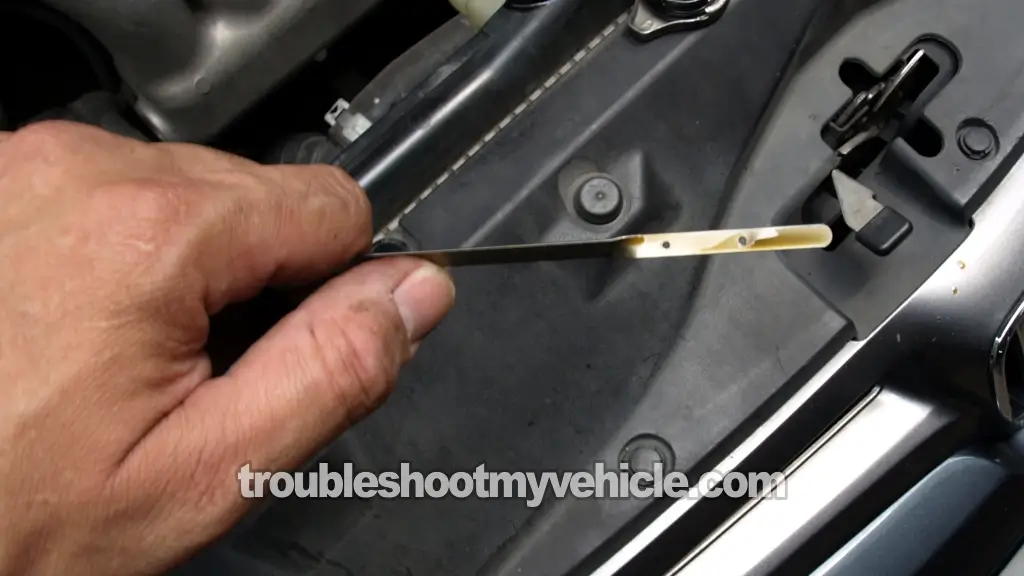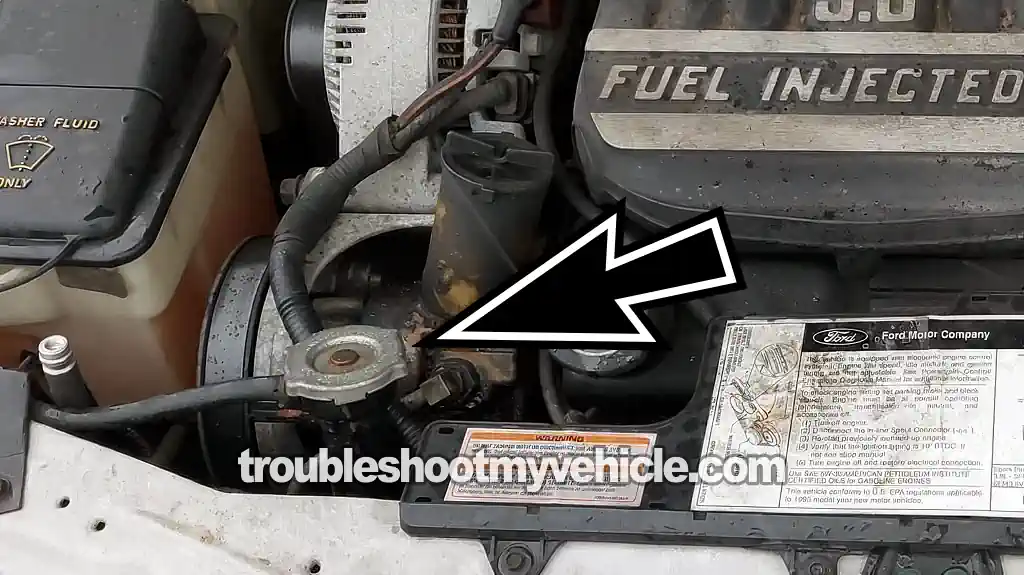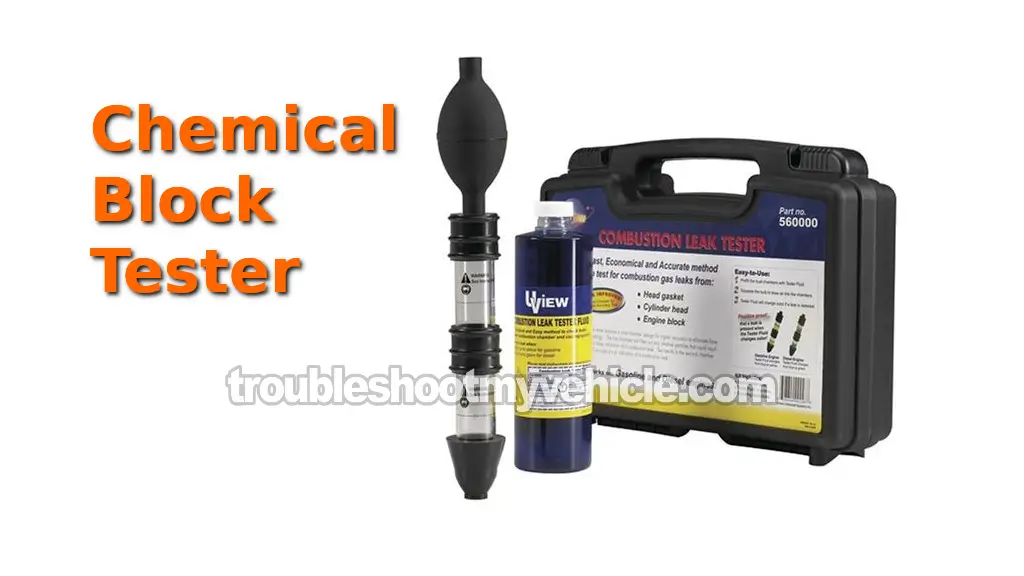
If your 3.8L V6 Ford Taurus or Mercury Sable is overheating —and you've already verified the thermostat, fan motor, and water pump aren't the problem— you may have a blown head gasket on your hands.
In this tutorial, I'll help you get to the bottom of it with four easy blown-head-gasket tests. All four are explained step by step and, more importantly, include an interpretation of your results (after all, what good is a test if you don't know how to read what you just did?).
Two of the tests require no tools at all. The other two use an engine compression tester and a block tester (combustion leak tester).
Contents of this tutorial:
- Symptoms Of A Blown Head Gasket.
- TEST 1: Oil The Color Of 'Coffee With Too Much Creamer'.
- TEST 2: Exhaust Gases Shooting Out Of An Open Radiator.
- TEST 3: Doing A Compression Test.
- TEST 4: Using A Chemical Block Tester (Combustion Leak Tester).
- Frequently Asked Questions.
- More 3.8L V6 Ford Taurus Diagnostic Tutorials.
APPLIES TO: This tutorial applies to the following vehicles:
- 3.8L V6 Ford Taurus: 1990, 1991, 1992, 1993, 1994, 1995.
- 3.8L V6 Mercury Sable: 1990, 1991, 1992, 1993, 1994, 1995.
3.0L/3.8L TAURUS, WINDSTAR AND RANGER: The head-gasket test for the 3.0L V6 Taurus, Sable, and Ranger -and- the 3.8L V6 Windstar can be found here:
- How To Test For A Blown Head Gasket (1990-2007 3.0L V6 Ford Taurus, Mercury Sable).
- How To Test For A Blown Head Gasket (1995-2003 3.8L V6 Ford Windstar).
- How To Test For A Blown Head Gasket (1991-2008 3.0L V6 Ford Ranger) (at: easyautodiagnostics.com).
Symptoms Of A Blown Head Gasket
The most common cause of a blown head gasket is engine overheating, which can happen when:
- The fan motor stops working.
- All of the coolant leaks out of the engine, and the vehicle is driven in this condition.
- The thermostat goes bad and gets stuck closed, preventing coolant from circulating.
Although this isn't a complete list, here are the most common symptoms of a blown head gasket:
- Your Ford Taurus (Mercury Sable) is overheating. You know it's not the fan (or fan clutch) or thermostat.
- White smoke is coming out of the tail-pipe and it smells like anti-freeze being cooked.
- The engine won't start.
- You have already verified it's not an ignition system problem because you have spark coming out at all of the spark plug wires.
- You know it's not a lack of fuel, because you have verified that the fuel pump is delivering fuel to the fuel injectors.
- The engine oil is thick and tan to off-white color (mixed with coolant).
TEST 1: Oil The Color Of 'Coffee With Too Much Creamer'

For our first test, we're going to check the condition of the oil on the engine oil dipstick of your Ford Taurus or Mercury Sable.
This test takes less than a minute to do —and in about 90% of cases, it'll confirm that one or both head gaskets are blown.
If this test doesn't confirm a head gasket failure, don't worry —we'll move on to the other tests and keep checking.
All right, let's get this show on the road.
- 1
Open the hood of your Taurus (or Sable).
- 2
Pull out the engine's oil dipstick.
- 3
Check the color of the oil.
- 4
You'll see one of two things:
1.) The engine oil will be a creamy tan/off white color and as thick as syrup.
2.) The engine oil will be a normal color and viscosity.
Now, let's find out what your test result means:
CASE 1: The color of the oil is a tan/off white color. This is not good —it proves beyond a shadow of a doubt that one or both head gaskets are blown on your Taurus or Sable.
Why does the oil look like this? Mainly because the engine overheated and:
- The overheating caused the cylinder head (or heads) to warp, which in turn burned the head gasket (or gaskets).
- Since the head gasket's job is to keep everything sealed and separated (engine oil, coolant, compression, exhaust gases, etc.), once it fails, these fluids start to mix.
- As the engine runs or cranks, coolant mixes with the engine oil —and this combination turns into a milky off-white or tan color.
CASE 2: The color of the engine oil is normal. This is good news —but you're not out of the woods yet. You'll need to perform the next two tests to either confirm a blown head gasket or rule it out completely. Head over to: TEST 2: Exhaust Gases Shooting Out Of An Open Radiator.
Here's why: Any experienced automotive mechanic or technician will tell you that one of the most common signs of a blown head gasket is oil mixing with coolant. This happens in about 90% of head gasket failure cases. However, in the other 10%, you won't see this symptom —which means further testing is needed to know for sure.
The next test will check if the engine's compression and combustion gases are escaping through the radiator.
TEST 2: Exhaust Gases Shooting Out Of An Open Radiator

The second most common test to check for a blown head gasket is to see if engine compression, combustion, or exhaust gases are escaping into the cooling system. This is a super easy test and doesn't require any tools at all.
All you need to do is remove the radiator cap and check whether the coolant gets forcefully shot out while cranking the engine.
IMPORTANT: If the engine has been running and is hot, let it cool down completely before removing the radiator cap. Never remove the radiator cap from a hot engine —doing so can cause serious burns from scalding hot coolant. Once the engine is completely cool, you're ready to begin.
OK, here are the test steps:
- 1
Remove the cap from the radiator.
- 2
Check the coolant level.
If empty, add some water or coolant to bring the coolant level to full. - 3
Now, get your helper to crank the engine, while you stand at a safe distance from the open radiator.
- 4
You'll see one of two results:
1.) The water or coolant inside the radiator will shoot up and out of the now open radiator.
2.) The coolant will not be disturbed. In other words, cranking the engine will have no effect on the level of the water or coolant in the radiator.
OK, now that the testing part is done, let's take a look at what your results mean:
CASE 1: The coolant bubbled out or shot out from the radiator. This is bad news and this let's you know beyond a shadow of a doubt that one or both head gaskets are blown. No further testing is required.
CASE 2: The coolant DID NOT bubble out NOR shoot out from the radiator. This is the correct test result.
Your next step depends on what the engine is doing:
- If the engine starts and runs but has a misfire: Your next step is to perform a compression test. Head over to: TEST 3: Doing A Compression Test.
- If the engine starts and runs but overheats within minutes: Your next step is to perform: TEST 4: Using A Chemical Block Tester (Combustion Leak Tester).
TEST 3: Doing A Compression Test

One of the most overlooked tests to determine if the head gasket is bad is the engine compression test. Why?
Because most folks perform only the first two tests (TEST 1 and TEST 2). When they don't see engine oil mixing with the coolant, or combustion gases bubbling out of the radiator, they assume everything's fine.
What often gets missed is that a head gasket can fail in a way that only affects compression between cylinders —and most guides never mention checking it.
The compression test checks whether the head gasket has burned through at a point between cylinders. If it has, compression and combustion from one cylinder will leak into the other (and vice versa), and the compression readings will clearly reveal that this has happened.
NOTE: For a more detailed explanation of how to perform and interpret the compression test on your Ford Taurus or Mercury Sable, see this tutorial: How To Test The Engine Compression (1990-1995 3.8L V6 Ford Taurus, Mercury Sable).
OK, here's what you need to do:
- 1
Disable the ignition system. It's important that spark is not created and delivered to the spark plug wires.
You can easily accomplish this 'disabling' by disconnecting the ignition module's electrical connector or the ignition coil's electrical connector (if your vehicle has a distributor) or the ignition coil pack's electrical connector. - 2
Disable the fuel system. It's important that fuel not be injected into the engine.
You can do this by removing the fuel pump relay or the fuel pump fuse. - 3
Disconnect all spark plug wires (from their spark plugs) and then take out all of the spark plugs. Before you remove the spark plug wires, label them so that you'll be able to easily reconnect them to their proper original locations.
- 4
Thread in the compression tester by hand, on the first spark plug hole you're gonna' start with.
Do not use any tools to tighten the compression tester. Hand tightening the compression tester is more than enough to get the proper results. - 5
Have a helper crank the engine. Your job is to observe the compression tester.
- 6
Once the gauge's needle stops climbing, have your assistant stop cranking the engine.
- 7
Write down the reading and what cylinder it belongs to (you can use the image in the image viewer to help you identify the cylinder) on a piece of paper.
- 8
Remove the compression tester and repeat the above steps in the remaining cylinders.
OK, let's take a look at what your results mean:
CASE 1: All cylinder compression readings where normal. These compression gauge readings confirm that the head gasket is OK and not burned at a point between two cylinders.
If you still suspect a head gasket failure, it's a good idea to perform a Combustion Leak Detector Test. For more information on how to do this test, head over to: TEST 4: Using A Chemical Block Tester (Combustion Leak Tester).
CASE 2: Two side by side cylinders had 0 PSI compression. This engine compression reading confirms that the head gasket is burned thru' at the point between those two cylinders. You'll need to replace the head gasket.
TEST 4: Using A Chemical Block Tester (Combustion Leak Tester)

In some cases a head gasket has failed, but the first three tests are not able to confirm that it is.
In other words, even though one of the head gaskets has failed, the engine coolant isn't mixed with the engine oil, the coolant within the radiator isn't being shot out of the open coolant tank (while cranking the engine), and engine compression was OK. Yet the engine is overheating for no apparent reason at all.
In these hard to diagnose blown head gasket cases, the only way to find out if the head gasket is blown (or not) is to do a block test with a block tester.
You do have to buy (or borrow) the block tester, but this tool is worth every penny since it's a test that gives you a very accurate test result.
In a nutshell, this is how a block tester works:
- A blue liquid chemical, which is blue in color, is placed in the tester (see photo above).
- The tester assembly is then placed on the open radiator neck (you may have to drain some of the coolant in the radiator since this tool needs to 'gulp' some of the air inside the radiator).
- The engine is started.
- The rubber bellow is then squeezed to suck in the air up through the two fluid-filled chambers. As the air bubbles up through the fluid, it will cause a chemical reaction.
- If the blue chemical turns yellow (for gasoline engines), combustion gases are entering the radiator. This result confirms a head gasket failure, a cracked block, or a cracked cylinder head issue.
- If the blue chemical doesn't change color, you can conclude that you don't have a head gasket failure, a cracked block, or a cracked cylinder head issue.
Where can you get the chemical and block tester? At your local auto parts store or here:
Disclosure: As an Amazon Associate, I earn from qualifying purchases. If my tutorials help you, using these links is an easy way to support the site at no extra cost to you. Thank you!
Frequently Asked Questions
1.) Do I need to remove both cylinder head?
Yes, if you have confirmed that the engine has a head gasket failure, you have to remove and check both cylinder heads for cracks and warpage.
1.) How can I tell if the cylinder head is cracked?
The cylinder head has to be removed and visually inspected. If the crack is wide enough, you'll be able to easily see it.
Sometimes, a visual inspection proves inconclusive, this is why it's important to let a machine shop pressure test it for you.
2.) Do I need to resurface the cylinder head?
YES, you need to resurface both cylinder heads! You should never reinstall the cylinder head without first having an automotive machine shop resurface it. Especially if your Ford's engine overheated.
Now, of course, if you (or the machine shop) have checked it with a straight-edge and there's no warpage then, and only then is the cylinder head not resurfaced.
More 3.8L V6 Ford Taurus Diagnostic Tutorials
You can find a complete list of diagnostic tutorials for the 3.8L V6 Ford Taurus and Mercury Sable in this index:
Here's a sample of the tutorials you'll find for the 3.8L Ford Taurus (Mercury Sable):
- How To Test The TPS With A Multimeter (1990-1995 3.8L V6 Taurus, Mercury Sable).
- How To Test The MAF Sensor (1991-1995 3.8L V6 Ford Taurus, Mercury Sable).
- How To Test The Fuel Pump (1990-1995 3.8L V6 Ford Taurus, Mercury Sable).
- How To Test The Engine Compression (1990-1995 3.8L V6 Ford Taurus, Mercury Sable).

If this info saved the day, buy me a beer!




